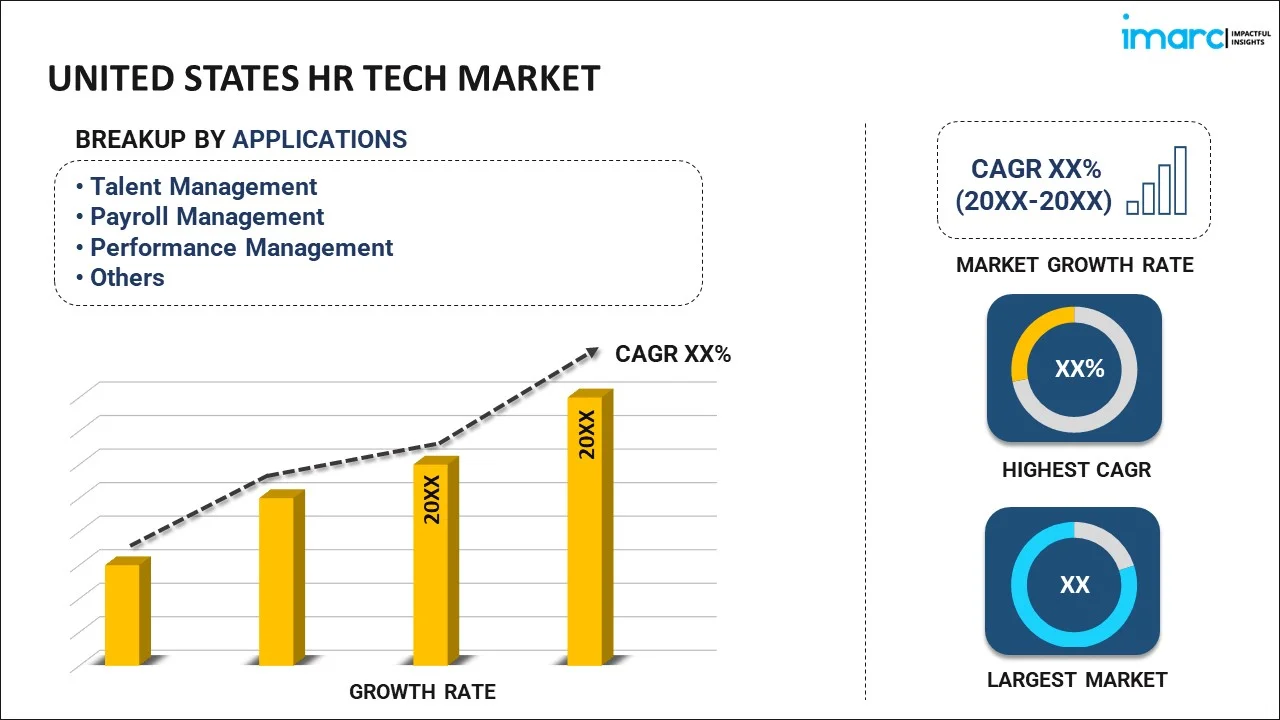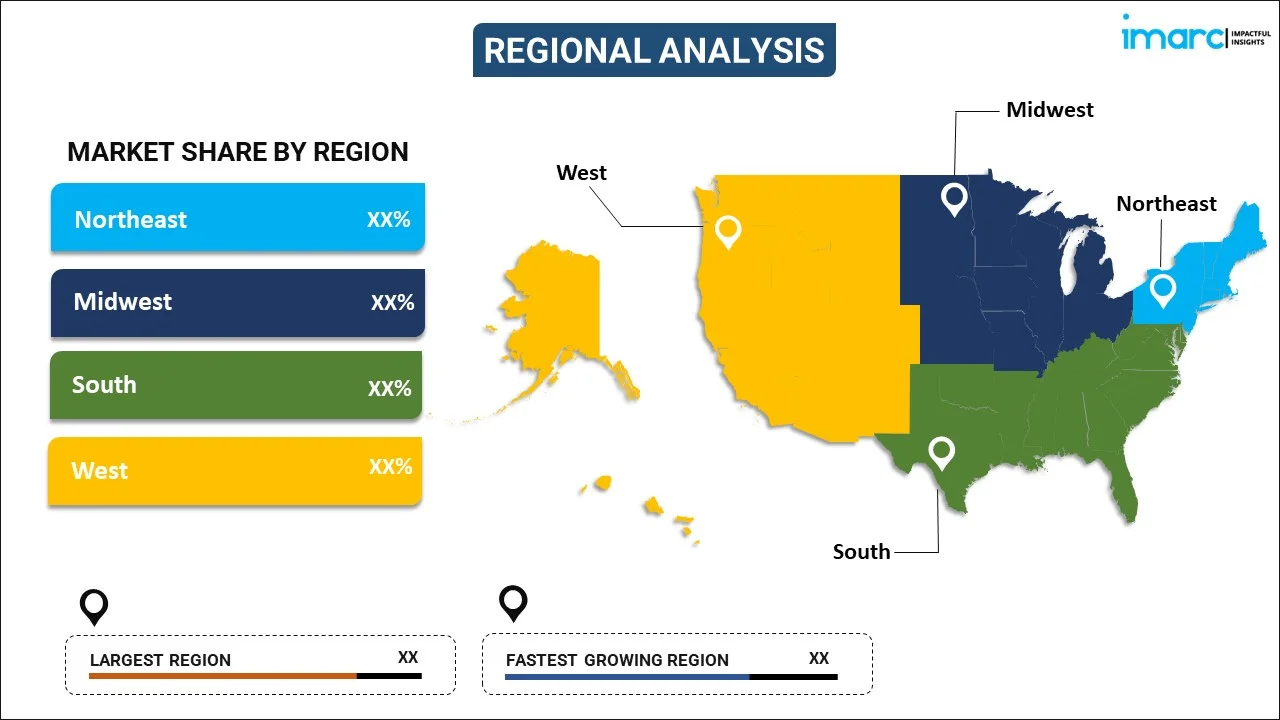
United States HR Tech Market Report by Application (Talent Management, Payroll Management, Performance Management, Workforce Management, Recruitment, and Others), Type (Inhouse, Outsourced), End Use Industry (TTH (Travel, Transportation, Hospitality), Public Sector, Health Care, Information Technology, BFSI (Banking, Financial services, and Insurance), and Others), Company Size (Less than 1k Employees, 1k -5k Employees, Greater than 5k Employees), and Region 2025-2033
Market Overview:
United States HR tech market size reached USD 8.2 Billion in 2024. Looking forward, IMARC Group expects the market to reach USD 22.9 Billion by 2033, exhibiting a growth rate (CAGR) of 12.1% during 2025-2033. The increasing digitalization of business processes, rising remote and hybrid work models, ongoing shift towards data analytics in HR processes, and the integration of artificial intelligence (AI) and machine learning (ML) represent some of the key factors driving the market.
|
Report Attribute
|
Key Statistics
|
|---|---|
|
Base Year
|
2024
|
|
Forecast Years
|
2025-2033
|
|
Historical Years
|
2019-2024
|
|
Market Size in 2024
|
USD 8.2 Billion |
|
Market Forecast in 2033
|
USD 22.9 Billion |
| Market Growth Rate 2025-2033 | 12.1% |
Human resources (HR) technology refers to the software and hardware used to automate and streamline HR functions in organizations. It encompasses a wide range of tools and applications designed to manage employee data, recruitment processes, payroll, benefits administration, performance management, and employee engagement. HR tech is comprised of several components, including human resource information systems (HRIS), applicant tracking systems (ATS), employee engagement platforms, and performance management systems. It possesses several features, such as automation of routine tasks, data analytics, integration capabilities, self-service portals, and compliance management. HR tech finds applications in talent acquisition, onboarding, payroll management, time and attendance tracking, benefits administration, performance appraisal, succession planning, learning and development, employee engagement, and workforce analytics. It offers improved efficiency, data-driven decision-making, enhanced employee experience, cost savings, regulatory compliance, scalability, real-time insights, streamlined communication, and strategic HR planning. In addition, HR tech is known for its increased productivity, better talent management, reduced manual errors, improved data security, enhanced collaboration, greater transparency, and more effective training programs.
United States HR Tech Market Trends:
The increasing digitalization of business processes, prompting companies in the United States to adopt HR tech to enhance efficiency and productivity, is propelling the market growth. Additionally, the rising remote and hybrid work models, which necessitate sophisticated HR tech solutions for managing a distributed workforce effectively, are boosting the market growth. Besides this, the ongoing shift towards data analytics in HR processes, enabling businesses to make informed decisions based on workforce data, is catalyzing the market growth. Furthermore, the growing demand for automation in routine HR tasks to reduce manual errors and free up HR professionals to focus on strategic initiatives is contributing to the market growth. In addition, the integration of artificial intelligence (AI) and machine learning (ML) in HR tech tools to augment talent acquisition, employee engagement, and predictive analytics is positively influencing the market growth. Apart from this, the rapidly evolving regulatory landscape, which requires robust HR tech solutions to ensure compliance with labor laws and regulations, is providing a considerable boost to the market growth. Moreover, the growing demand for innovative HR tech due to increasing emphasis on improving the employee experience, is acting as another growth-inducing factor. Along with this, the escalating need for scalable and flexible HR tech systems, owing to the expanding organization infrastructure, is favoring the market growth. Additionally, the widespread tech adoption due to its ability to reduce operational costs and increase return on investments (ROI), is bolstering the market growth. Furthermore, the growing gig economy in the United States, which requires specialized HR Tech tools to manage contract and freelance workers, is supporting the market growth.
United States HR Tech Market Segmentation:
IMARC Group provides an analysis of the key trends in each segment of the market, along with forecasts at the country level for 2025-2033. Our report has categorized the market based on application, type, end use industry, and company size.
Application Insights:

- Talent Management
- Payroll Management
- Performance Management
- Workforce Management
- Recruitment
- Others
The report has provided a detailed breakup and analysis of the market based on the application. This includes talent management, payroll management, performance management, workforce management, recruitment, and others.
Type Insights:
- Inhouse
- Outsourced
A detailed breakup and analysis of the market based on the type have also been provided in the report. This includes inhouse and outsourced.
End Use Industry Insights:
- TTH (Travel, Transportation, Hospitality)
- Public Sector
- Health Care
- Information Technology
- BFSI (Banking, Financial services, and Insurance)
- Others
The report has provided a detailed breakup and analysis of the market based on the end use industry. This includes TTH (travel, transportation, hospitality), public sector, health care, information technology, BFSI (banking, financial services, and insurance), and others.
Company Size Insights:
- Less than 1k Employees
- 1k -5k Employees
- Greater than 5k Employees
A detailed breakup and analysis of the market based on the company size have also been provided in the report. This includes less than 1k employees, 1k -5k employees, and greater than 5k employees.
Regional Insights:

- Northeast
- Midwest
- South
- West
The report has also provided a comprehensive analysis of all the major regional markets, which include the Northeast, Midwest, South, and West.
Competitive Landscape:
The market research report has also provided a comprehensive analysis of the competitive landscape. Competitive analysis such as market structure, key player positioning, top winning strategies, competitive dashboard, and company evaluation quadrant has been covered in the report. Also, detailed profiles of all major companies have been provided.
United States HR Tech Market Report Coverage:
| Report Features | Details |
|---|---|
| Base Year of the Analysis | 2024 |
| Historical Period | 2019-2024 |
| Forecast Period | 2025-2033 |
| Units | Billion USD |
| Scope of the Report | Exploration of Historical and Forecast Trends, Industry Catalysts and Challenges, Segment-Wise Historical and Predictive Market Assessment:
|
| Applications Covered | Talent Management, Payroll Management, Performance Management, Workforce Management, Recruitment, Others |
| Types Covered | Inhouse, Outsourced |
| End Use Industries Covered | TTH (Travel, Transportation, Hospitality), Public Sector, Health Care, Information Technology, BFSI (Banking, Financial services, and Insurance), Others |
| Company Sizes Covered | Less than 1k Employees, 1k -5k Employees, Greater than 5k Employees |
| Regions Covered | Northeast, Midwest, South, West |
| Customization Scope | 10% Free Customization |
| Post-Sale Analyst Support | 10-12 Weeks |
| Delivery Format | PDF and Excel through Email (We can also provide the editable version of the report in PPT/Word format on special request) |
Key Questions Answered in This Report:
- How has the United States HR tech market performed so far and how will it perform in the coming years?
- What has been the impact of COVID-19 on the United States HR tech market?
- What is the breakup of the United States HR tech market on the basis of application?
- What is the breakup of the United States HR tech market on the basis of type?
- What is the breakup of the United States HR tech market on the basis of end use industry?
- What is the breakup of the United States HR tech market on the basis of company size?
- What are the various stages in the value chain of the United States HR tech market?
- What are the key driving factors and challenges in the United States HR tech?
- What is the structure of the United States HR tech market and who are the key players?
- What is the degree of competition in the United States HR tech market?
Key Benefits for Stakeholders:
- IMARC’s industry report offers a comprehensive quantitative analysis of various market segments, historical and current market trends, market forecasts, and dynamics of the United States HR tech market from 2019-2033.
- The research report provides the latest information on the market drivers, challenges, and opportunities in the United States HR tech market.
- Porter's five forces analysis assist stakeholders in assessing the impact of new entrants, competitive rivalry, supplier power, buyer power, and the threat of substitution. It helps stakeholders to analyze the level of competition within the United States HR tech industry and its attractiveness.
- Competitive landscape allows stakeholders to understand their competitive environment and provides an insight into the current positions of key players in the market.
Need more help?
- Speak to our experienced analysts for insights on the current market scenarios.
- Include additional segments and countries to customize the report as per your requirement.
- Gain an unparalleled competitive advantage in your domain by understanding how to utilize the report and positively impacting your operations and revenue.
- For further assistance, please connect with our analysts.
 Inquire Before Buying
Inquire Before Buying
 Speak to an Analyst
Speak to an Analyst
 Request Brochure
Request Brochure
 Request Customization
Request Customization




.webp)




.webp)












